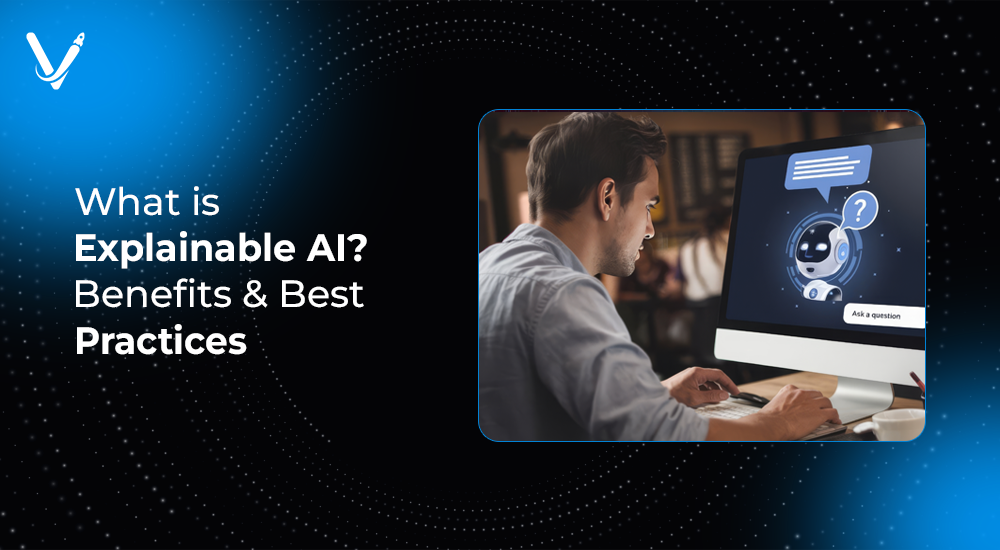What is Explainable AI? Benefits & Best Practices


- May 11, 2025
Artificial intelligence (AI) is reshaping industries by automating complex tasks, making data-driven predictions, and enabling intelligent decision-making. However, as AI systems become more sophisticated, they also become more opaque, often resembling black boxes that produce outcomes without clear explanations. This lack of transparency raises concerns about trust, accountability, and ethical implications.
Explainable AI (XAI) — a framework that seeks to make AI systems more understandable to humans. It bridges the gap between complex AI models and end-users by providing insights into how decisions are made, why specific predictions are generated, and what factors influence outcomes. This article explores the concept of Explainable AI, its key benefits, real-world applications, and best practices for implementing explainability in AI systems.
Explainable AI refers to techniques and methods that make the decision-making processes of AI systems transparent and interpretable to humans. Unlike traditional AI models that operate as black boxes, XAI provides clear explanations for each decision, helping stakeholders understand how inputs lead to specific outputs.
Key Components of Explainable AI:
Example:
A healthcare AI model predicts the likelihood of a patient developing diabetes. With XAI, the model not only provides the prediction but also specifies contributing factors such as age, BMI, family history, and glucose levels.
Explainable AI is crucial for several reasons, particularly in high-stakes industries like healthcare, finance, and autonomous vehicles. Here are key reasons why XAI matters:
1. Building Trust and Transparency:
AI models that explain their decisions foster greater trust among users. When stakeholders understand the reasoning behind predictions, they are more likely to accept and act upon AI-driven recommendations.
Example:
In credit scoring, an AI model predicts that a loan application is high risk. With XAI, the bank can provide a clear explanation, such as low credit score, high debt-to-income ratio, and recent payment delinquencies.
2. Ensuring Accountability and Compliance:
Regulations such as GDPR and the AI Act require organizations to provide explanations for automated decisions, especially when they impact individuals' rights. XAI helps companies comply with these regulations by making AI models auditable and interpretable.
3. Detecting Bias and Mitigating Risks:
AI models trained on biased datasets can produce discriminatory outcomes. Explainable AI identifies potential biases and enables developers to adjust algorithms to ensure fairness.
4. Enhancing User Experience:
Users are more likely to adopt AI systems that provide clear and actionable explanations. XAI helps users understand why certain recommendations are made and how they can optimize outcomes.
Explainable AI can be categorized into two main types:
1. Post-Hoc Explainability:
This approach applies after the model is trained and deployed. It provides explanations without altering the underlying model. Techniques include:
2. Intrinsic Explainability:
In this approach, the model is designed to be interpretable from the outset. Techniques include:
Implementing Explainable AI offers several advantages across industries:
1. Improved Transparency and Trust:
Explainable AI demystifies complex models, fostering user confidence in AI systems. This is particularly valuable in sectors like healthcare, where decisions impact patient outcomes.
Example:
An AI diagnostic tool predicts the likelihood of lung cancer based on CT scans. By explaining how the model identified specific tumor patterns, physicians can better understand the rationale behind the diagnosis.
2. Regulatory Compliance:
Compliance with data protection and AI regulations requires transparent AI systems. XAI ensures that organizations can provide explanations for automated decisions, reducing legal risks.
3. Bias Detection and Mitigation:
AI models trained on biased data can perpetuate discrimination. Explainable AI highlights biases, allowing developers to adjust algorithms for fairer outcomes.
4. Enhanced Model Debugging and Optimization:
XAI provides insights into how models process data, enabling developers to identify errors, optimize model performance, and improve accuracy.
5. Better User Experience and Adoption:
Users are more likely to adopt AI systems that provide actionable insights. XAI enhances user satisfaction by offering clear explanations and actionable recommendations.
Explainable AI is making significant impacts in various sectors:
1. Healthcare:
AI diagnostic systems like IBM Watson Health use XAI to explain predictions related to cancer diagnosis and treatment recommendations.
2. Finance:
Financial institutions deploy XAI to justify credit scoring decisions, detect fraudulent transactions, and assess loan eligibility.
3. Autonomous Vehicles:
AI systems in self-driving cars use XAI to explain decisions in real-time, such as why the vehicle chose a specific route or avoided a collision.
4. Legal and Compliance:
Law firms use XAI to analyze case data, predict legal outcomes, and explain the reasoning behind recommendations.
To effectively implement XAI, consider the following best practices:
Explainable AI is more than a buzzword — it is a fundamental component of responsible AI development. By providing transparency, interpretability, and accountability, XAI bridges the gap between AI models and human users, ensuring that AI-driven decisions are ethical, fair, and trustworthy.
At Vasundhara Infotech, we specialize in developing AI solutions that prioritize transparency and explainability, empowering businesses to harness AI without compromising on trust or compliance. Ready to implement Explainable AI in your projects? Contact us today to learn how we can help.
Copyright © 2025 Vasundhara Infotech. All Rights Reserved.
